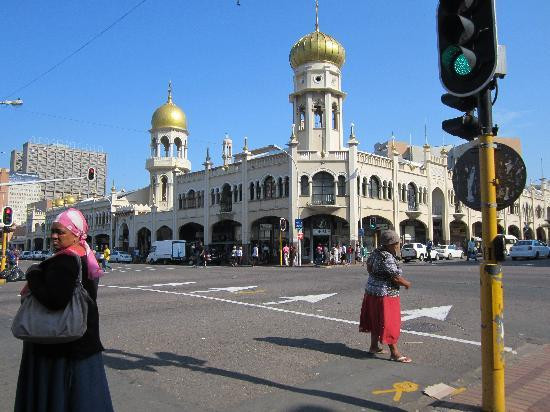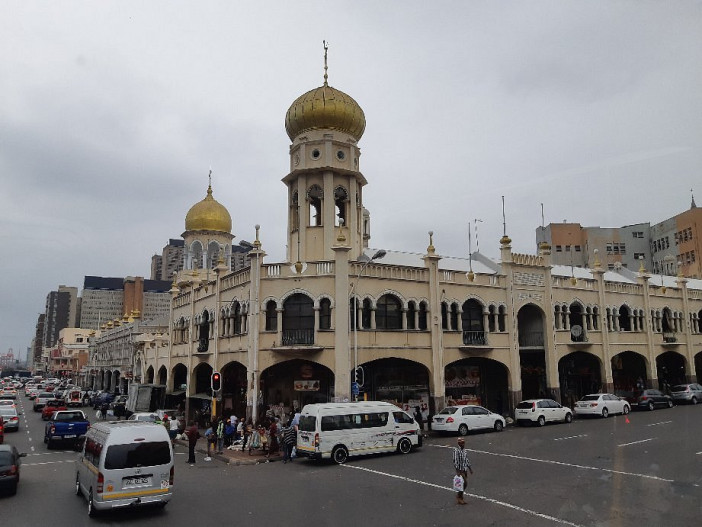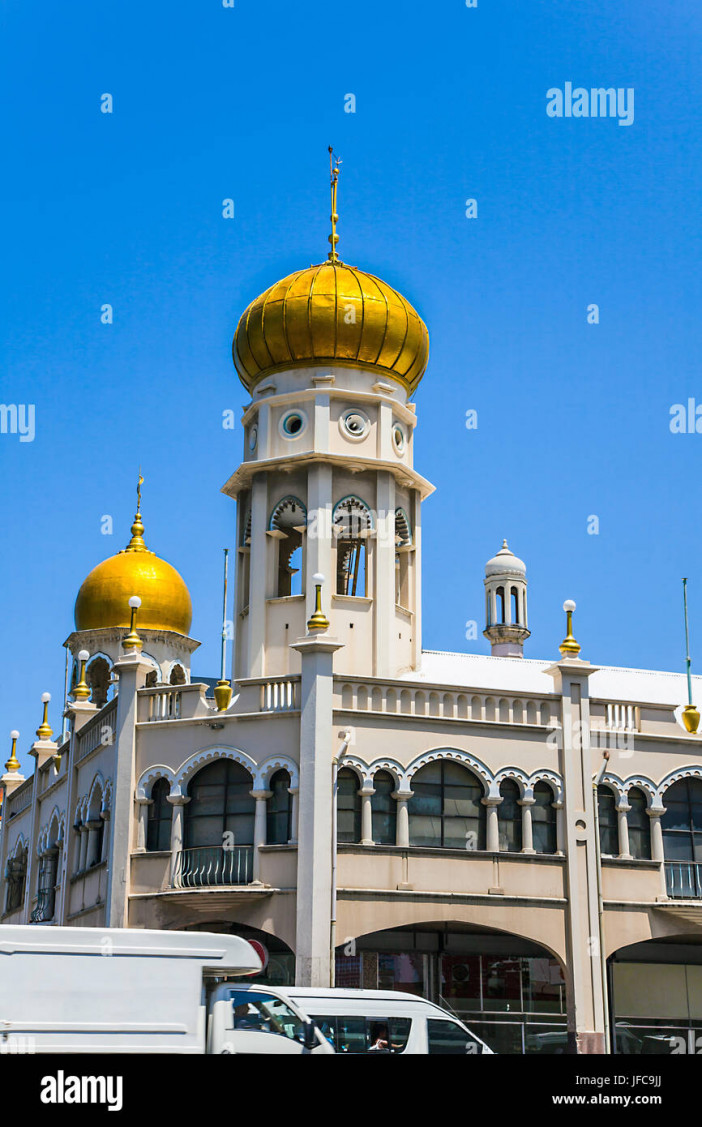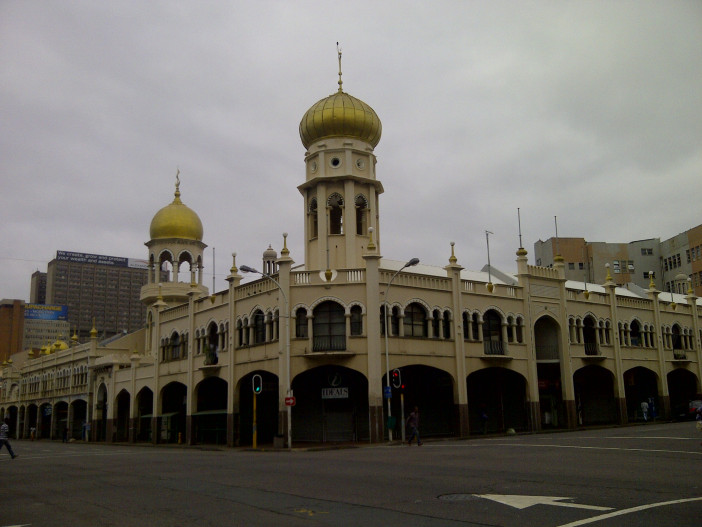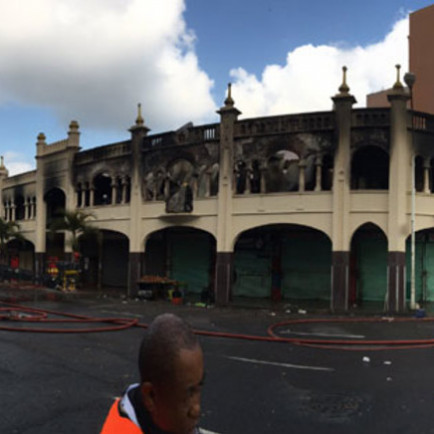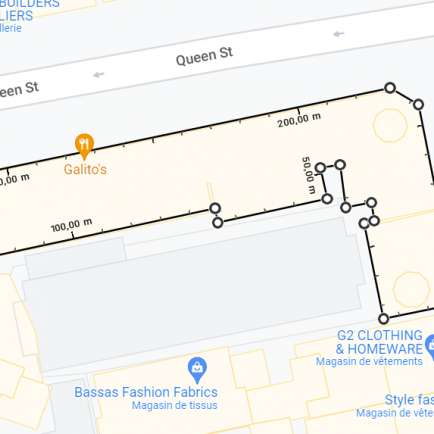The Juma Mosque of Durban
History
In August 1881, a site was bought by Aboobaker Amod Jhaveri and Hajee Mohamed in Gray Street (now known as Dr. Yusuf Dadoo Street) from K. Munsamy for £115 for the construction of a mosque. A tiny brick and mortar structure which stood on the site was converted into the mosque.
In February 1884 Aboobaker's estate bought land next to the mosque to enable its further expansion. In 1889 Hajee Mahomed Dada, in his capacity as the only surviving trustee of the mosque purchased more adjoining land due to the swift rise in the number of worshipers. The first of the two minarets on the mosque was constructed in 1904. At the same time, two shops were built alongside the mosque providing an income for its maintenance. A second minaret was added to the mosque in 1905 and several rooms, toilets and shower facilities were also added at the rear of the mosque for travelers to use. Rooms were also built for the Mu‘adh-dhin
Urban and Architectural
With space for up to 5,000 worshippers, Jumma Mosque (also known as Juma Masjid) is the largest mosque in the Southern Hemisphere. It is also one of its oldest, its impressive minarets having dominated the Indian quarter of Durban for more than a hundred years, its shops sheltered on the ground floor forming an intercultural dialogue with the rest of the city.
The building is a fascinating blend of Mughal Indian and South African colonial styles, distinguished by the archways and decorative plasterwork of the off-white exterior and the serene marble of the surprisingly spacious interior, which provides an oasis from commercial activity lively in the region.
Description
Architect Payne & Payne
References
https://mapcarta.com/fr/W471726381
https://www.sa-venues.com/things-to-do/kwazulunatal/visit-the-juma-masjid-mosque/
https://en.wikipedia.org/wiki/Juma_Mosque_(Durban)
Details
Location
62 Cathedral Rd, Durban Central, Durban, 4001, South africa
Worshippers
3000
Owners
Aboobaker Amod Jhaveri and Hajee Mohamed
Year of Build
1927
Area
2000
Drawings
Map
History
In August 1881, a site was bought by Aboobaker Amod Jhaveri and Hajee Mohamed in Gray Street (now known as Dr. Yusuf Dadoo Street) from K. Munsamy for £115 for the construction of a mosque. A tiny brick and mortar structure which stood on the site was converted into the mosque.
In February 1884 Aboobaker's estate bought land next to the mosque to enable its further expansion. In 1889 Hajee Mahomed Dada, in his capacity as the only surviving trustee of the mosque purchased more adjoining land due to the swift rise in the number of worshipers. The first of the two minarets on the mosque was constructed in 1904. At the same time, two shops were built alongside the mosque providing an income for its maintenance. A second minaret was added to the mosque in 1905 and several rooms, toilets and shower facilities were also added at the rear of the mosque for travelers to use. Rooms were also built for the Mu‘adh-dhin
Urban and Architectural
With space for up to 5,000 worshippers, Jumma Mosque (also known as Juma Masjid) is the largest mosque in the Southern Hemisphere. It is also one of its oldest, its impressive minarets having dominated the Indian quarter of Durban for more than a hundred years, its shops sheltered on the ground floor forming an intercultural dialogue with the rest of the city.
The building is a fascinating blend of Mughal Indian and South African colonial styles, distinguished by the archways and decorative plasterwork of the off-white exterior and the serene marble of the surprisingly spacious interior, which provides an oasis from commercial activity lively in the region.
Description
Architect Payne & Payne


